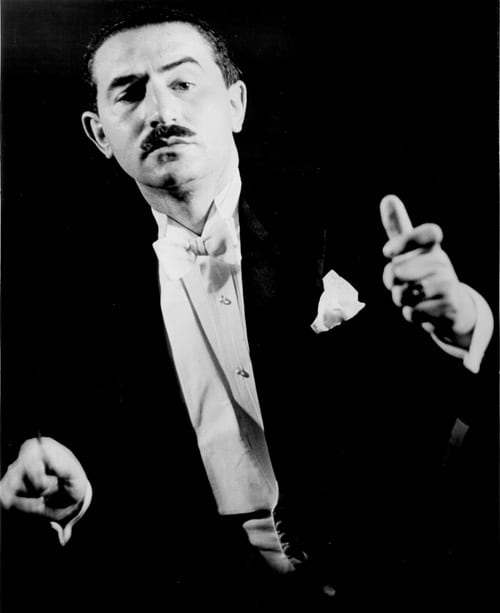
Roman Ryterband (1914-1979) completed his Sonatina for Classical Guitar in 1978. It was his last finished work and an opus on which he certainly lavished much creative attention. In 2016, the composer’s family donated to the Polish Music Center the Sonatina’s manuscript together with other documents that now constitute the PMC’S Ryterband Collection, and performances of many of his works can be found amongst the PMC’s YouTube channel playlists.
This singular and fascinating composition immediately attracted the attention of Tomasz Fechner, a virtuoso guitarist and former Fulbright scholar and doctoral student of classical guitar at USC Thornton School of Music (pictured above in the library of the Polish Music Center). Over the course of two years of his studies at Thornton, Maestro Fechner consulted the manuscript and various drafts for this work in the Ryterband Collection and corresponded with guitarists Byron Paul Tomingas, who advised the composer on various performance issues in the late 1970s, and Gregg Nestor, who created the first performing version of this work well after Ryterband’s death.

Ryterband’s Sonatina for Classical Guitar bears the following note from the composer on the manuscript:
“Tonal gravitations in the first movement are abundantly interspersed with surprising modulations, which frame the imitative linearity. The energetic opening statement and its development require considerable digital dexterity on the part of the performer as the texture explores all possibilities the guitar has to offer. An aura of long forgotten sagas, enhanced by the touch of the main theme’s Phrygian mode, provides serenity and repose in the second movement. The pulsating thrust of the closing Vivo displays virtuosity in the joyously playful section of the rondo. Rhythmic and harmonic changes, syncopations, lilting melodies, runs and strummed chords, make up a gamut of contrasts leading to a bravura finale.”
Maryanne Kremer-Ames gave the world premiere of the Sonatina at an Arizona Classic Guitar Society concert on November 6, 1991.
After consulting Ryterband’s manuscript and a few subsequent editions, Fechner prepared a new performing version of the Sonatina for a Polish Music Center concert in Los Angeles in April of 2016 and subsequently premiered it in Poland in June. After more revisions and a new engraving by Fechner, Ryterband’s Sonatina has been performed on numerous occasions—both in the United States and Poland—during the past three years before the pandemic. Finally, in late 2019, Fechner’s authoritative edition of the Sonatina was published by PWM Editions in Poland and is available at pwm.com.pl.
In addition to the final version of the score, now there is also an authoritative performance of the Sonatina on video, featuring Maestro Fechner. Produced in collaboration with Guitar Salon International and recorded in their Santa Monica studios, Tomasz Fechner’s video features three outstanding instruments in the Salon’s collections, one for each of the Sonatina’s movements.
The rhapsodic opening Allegro deciso is performed by Fechner on a 1960 Hernandez y Aguado classical guitar. This instrument’s fulsome tone and Fechner’s assured technical command of the complex textures that predominate throughout the first movement are on ample display here: https://www.youtube.com/watch?v=EyDPoz0P1Ko
The “serenity and repose” with hints of the “Phrygian mode”—as described in the introductory notes by the composer—were beautifully echoed in Fechner’s interpretation of the second movement played on a rare and gentle-sounding 1910 Hermann Hauser instrument. The combination of the mellow instrumental color palette and Fechner’s captivating musicianship indeed evoke the very atmosphere Roman Ryterband envisioned as he composed this Sonatina movement: https://www.youtube.com/watch?v=L0F0_IEf7a8
For the last movement’s variety of technical and musical challenges, Maestro Fechner chose a 2015 Sebastian Stenzel instrument. Its brilliant sound is exceptionally well matched to Fechner’s admittedly vigorous take on Ryterband’s music: https://www.youtube.com/watch?v=ppNasrgvg-E
Even though these separately recorded movements were posted within the last few weeks (the first on May 11, the second on May 17 and the last on May 26), they have already attracted several thousand viewers and an avalanche of positive comments. Guitarist Byron Tomingas, whose concert in Palm Springs many decades ago inspired Ryterband to compose the Sonatina, commented on Fechner’s interpretation in an email to the composer’s daughter:
“Playing these three movements on three different guitars is tremendously difficult. Especially when there’s strumming which can scratch the face of these expensive instruments. And yet, he plays them with exuberance which is exactly what they need to shine, well done indeed!”
Alongside comments about Maestro Fechner’s artistry are many expressions of amazement and appreciation for Roman Ryterband’s fascinating addition to the solo guitar repertoire. Given such a positive reception, one can hope that Ryterband’s Sonatina for Classical Guitar may finally begin its long-delayed journey to concert stages worldwide.
[Source: press release; Image sources: PMC Collection, voyagela.com]
